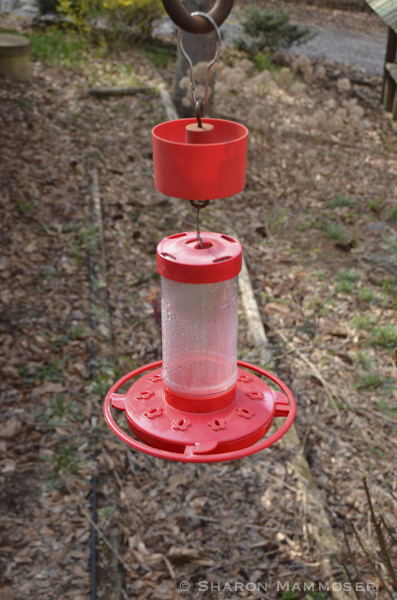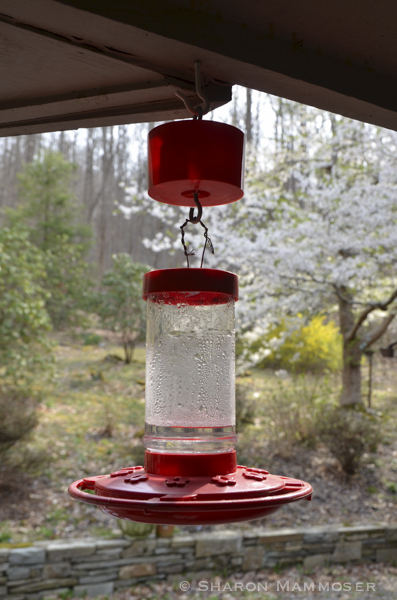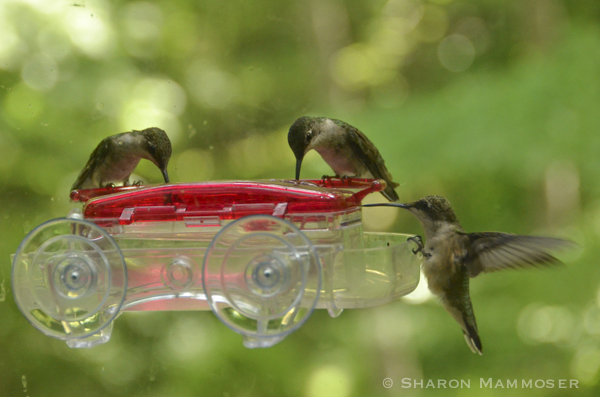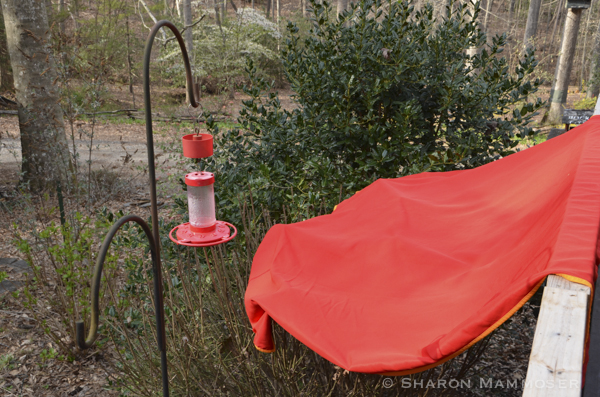Hey, hey, guess what!
The birds are back in town!!
Woo hoo the ruby throated hummingbirds are back!!! Have you seen one yet?
I have not seen one but have been frequently checking the spring migration map and know they were spotted in NC on March 19th. At my house in the woods, I don’t usually see the first ones until the first week of April but every year I am ever hopeful for an early arrival! You can check out the map to see when you might expect them in your neighborhood.
Do you love to feed and watch the hummingbirds?
Do you clean your feeders REGULARLY? Are you religious about watching for and eliminating BLACK MOLD? Do you change the nectar OFTEN during the hot summer months?
If you answered yes to those questions you have nothing to worry about, but if you answered NO to any of the last 3 questions, you could be causing the death of the birds you so love to watch!
It is a sad reality that biologists have been seeing a deadly fungus infection in the hummingbirds that causes their tongues to swell, essentially causing the birds to starve to death! And if that’s not bad enough, a mother hummingbird can pass the infection on to her babies who will also die of starvation.
If your feeders have BLACK MOLD and you just ignore it, this is one way they could come in contact with this infection.
And amazingly, there’s more.
You know that fermented sugar water that has become cloudy in your feeder? Fermented sugar water can cause liver damage and liver damage could cause death.
And sorry, but one more–YOU DO NOT need that red food coloring or store-bought nectar which also may be causing harm to the little birds you love so much.
So then, here’s 8 things you need to know about feeding hummingbirds:
1 Honestly, if you are not willing to clean and fill your feeders every two or three days, PLEASE don’t bother putting them out! Watching hummingbirds is wonderful but it requires a commitment on your part.

2.The best hummingbird feeders are the ones that are EASY to clean. I like the feeders that come completely apart for easy washing. There are many feeders on the market that don’t come apart at all! Making cleaning them IMPOSSIBLE! If you have these, throw them out and replace them with feeders you can clean. Some have a built-in ant moat–these are AWESOME! They cost more, but are totally worth it because the ants will not find their way to the nectar and eventually, will give up trying. (Here’s one I love) If you don’t have a built in ant moat, you can buy one and attach it to the top of the feeder. Another thing to look for in a hummingbird feeder is a resting spot for the birds, rather than feeders that require them to hover.

3. Speaking of cleaning your feeders… it’s not hard if you stay on top of it. Just bring them in every 2 to 3 days and flush with hot tap water. Use a sponge/ bottle brush/Q-tip to scrub inside all of the parts. You do not need to use soap as it can leave a residue. If you see any sign of mold–soak the feeder in 1/4 cup of bleach to one gallon of water for one hour and then rinse well, OR soak in a solution of 1/4 cup white vinegar to one gallon water for 15 minutes and rinse well.
4. Hang your feeder in the SHADE. The nectar will last longer this way and though we can’t ask them, the birds might appreciate the cooler spot too.

5. Make your own nectar solution, SANS RED FOOD COLORING. Just mix up 1 part regular sugar to 4 parts water. You can do this in hot tap water or you can boil it, but boiling is not necessary. Boiling it may slow fermentation but if you are replacing it regularly anyway, this won’t come up.
6. You should only put 2 or 3 days worth of nectar in the feeder. So if you have a giant feeder with a large holding area, don’t fill it up! It will just be a waste since it will have to be replaced before it empties. You can keep made-up solution in a pitcher in the fridge. (labeled of course so your guests don’t inadvertently become addicted to your sweet nectar)

7. Put your feeder either right at the window, or at least 5 feet away from a window to prevent collisions. There are window suction cup feeders that are great–especially if you have kids or are a kid yourself and love to see these amazing birds up close.
8. The sooner you get your feeders out, the better. If the birds come through and don’t find suitable food sources, they will keep traveling north. Having your feeders out when they pass through increases your chances of having them stay and call your yard “home.” I put out red blankets and towels to add more red to my yard and make the birds more likely to stop in to check it out–then discover one of 5 feeders around the house. This is not necessary! But it can’t hurt to make your yard more noticeable. 
One more thing! The birds can’t thank you, but I can!!
Thanks for caring about our hummingbirds!
And for taking the time to protect them and to spread the word to others. Together, we can make a difference.
Read more about the fungus infection at the Audubon Society


I have a 32 oz feeder with a following of 20 birds minimum . There is a male & female pair of oriole’s who use it too. I have to refill the feeder every morning – they buzz my head while I’m doing it and my husband watched them line up behind me. I scrub with detergent and hot water every 3 days. I found a bird on the feeder this morning with some sort of growth on its beak. What am I doing wrong?
Mary,
It sounds like you are doing all you can. How great that you have so many birds and that you take such time to make sure the feeder stays clean. Great job! As for the growth on its beak, it is hard to say. Don’t take it as a sign that you are doing something wrong–it would be impossible to identify the cause of the growth just by looking at it. Thanks for caring! And happy bird watching!